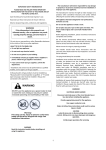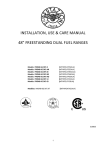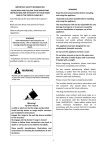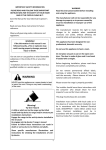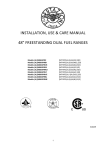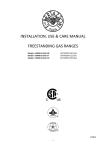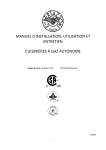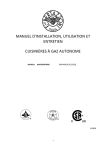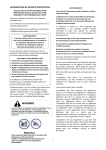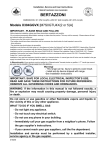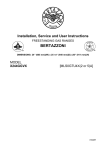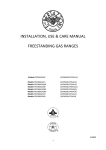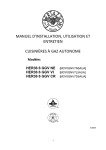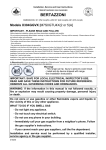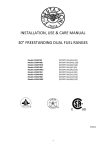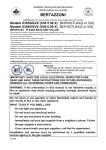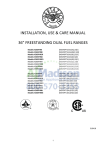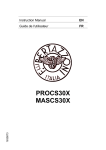Download PRO30 4 DFS Installation, Use & Care Manual
Transcript
INSTALLATION, USE & CARE MANUAL 30” FREESTANDING DUAL FUEL RANGES Models PRO30 4 DFS X Models PRO30 4 DFS AR Models PRO30 4 DFS BI Models PRO30 4 DFS NE Models PRO30 4 DFS RO Models PRO30 4 DFS VI Models MAS30 4 DFS XT [M7S0PTU7X5DUA] [M7S0PTU7S5DUA] [M7S0PTU7W5DUA] [M7S0PTU7N5DUA] [M7S0PTU7R5DUA] [M7S0PTU7L5DUA] [M7S0PTA7X5DUA] 310839 1 From the desk of the President Dear new owner of a Bertazzoni product, I want to thank you for choosing one of our beautiful PRO ranges. We know that you have many brands and products to choose from and we are thrilled that you have decided to take one of your products into your home. We take as much pride in making our ranges as we hope you will in owning them. My family started manufacturing cooking appliances in 1882. Each of our products is a blend of Italian design finesse and superior appliance technology. While we can not replace your unique talent at cooking delicious recipes for yourself, your family and your friends, we try our best to make cooking easier, more effective and more fun. BERTAZZONI SpA Via Palazzina 8 42016 Guastalla RE ITALY WWW.BERTAZZONI‐ITALIA.COM Our appliances are designed according to the strictest safety and performance standard for the European and the North American market. We follow the most advanced manufacturing philosophy. Each appliance leaves the factory after thorough quality inspection and testing. Our distributors and our service partners are ready to answer any questions you may have regarding how to install, use and care for your Bertazzoni product. This manual will help you learn to use the product in the safest and most effective manner and care for it so that it may give you the highest satisfaction for years to come. The manual also includes directions for the professional installer that will install the product in your home. We recommend using factory‐trained professionals for the delicate task of installing and testing appliances in your home. Please call Customer Service if you need help locating a factory‐trained professional installer in your area. Please keep this manual for future use. Grazie! 2 3 TABLE OF CONTENTS WARRANTY AND SERVICE ........................................................................................................................................ 6 CUSTOMER SERVICE ....................................................................................................................................................... 6 REPLACEMENT PARTS .................................................................................................................................................... 6 IMPORTANT SAFETY INFORMATION ........................................................................................................................ 7 BEFORE INSTALLATION .......................................................................................................................................... 10 INSTALLING THE LEGS ............................................................................................................................................ 11 INSTALLING THE WORKTOP FRONTGUARD ............................................................................................................ 11 INSTALLING THE BACKGUARD ................................................................................................................................ 12 INSTALLATION REQUIREMENTS ............................................................................................................................. 13 ELECTRICAL .................................................................................................................................................................. 13 GAS ............................................................................................................................................................................... 13 INSTALLATION ADJACENT TO KITCHEN CABINETS ................................................................................................... 14 EXHAUST HOOD INSTALLATION ............................................................................................................................. 14 ELECTRICAL CONNECTION ...................................................................................................................................... 15 WIRING DIAGRAM ................................................................................................................................................. 18 GAS CONNECTION ................................................................................................................................................. 19 PRESSURE REGULATOR ................................................................................................................................................ 20 GAS CONVERSION ................................................................................................................................................. 20 STEP 1: PRESSURE REGULATOR .................................................................................................................................... 20 STEP 2: SURFACE BURNERS .......................................................................................................................................... 21 STEP 3: MINIMUM FLAME ADJUSTMENT ..................................................................................................................... 21 GAS BURNERS DATA TABLES .................................................................................................................................. 22 INSTALLATION CHECKLIST ...................................................................................................................................... 23 INSTALLATION CHECKLIST ...................................................................................................................................... 23 FINAL PREPARATION ............................................................................................................................................. 23 USER MANUAL ...................................................................................................................................................... 24 ROOM VENTILATION ............................................................................................................................................. 24 SURFACE BURNER LAYOUT .................................................................................................................................... 25 SURFACE COOKING ................................................................................................................................................ 25 SYMBOLS ...................................................................................................................................................................... 25 SURFACE BURNER OPERATION .................................................................................................................................... 26 TIPS FOR USING BURNERS CORRECTLY ........................................................................................................................ 26 TIPS FOR USING PANS CORRECTLY ............................................................................................................................... 27 OVEN COOKING ..................................................................................................................................................... 27 SYMBOLS ...................................................................................................................................................................... 28 OVEN RACKS ................................................................................................................................................................. 28 OVEN FUNCTION SELECTOR ......................................................................................................................................... 28 USING THE OVEN ................................................................................................................................................... 29 OVEN LIGHT.................................................................................................................................................................. 29 COOLING FANS ............................................................................................................................................................. 29 FRONT INDICATOR LIGHTS ........................................................................................................................................... 29 SOUND BUZZER ............................................................................................................................................................ 29 OVEN CONVECTION FAN .............................................................................................................................................. 29 4 BAKE ..................................................................................................................................................................... 30 PREHEATING THE OVEN ..................................................................................................................................... 30 GETTING THE BEST RESULTS .............................................................................................................................. 30 BAKEWARE TYPE ................................................................................................................................................. 30 BAKE RACK POSITIONS ....................................................................................................................................... 30 CONVECTION ......................................................................................................................................................... 30 CONVECTION ....................................................................................................................................................... 30 CONVECTION BAKE ............................................................................................................................................. 30 TURBO ................................................................................................................................................................. 30 RACK POSITIONS ................................................................................................................................................. 31 BAKING RECOMMENDATIONS ........................................................................................................................... 32 WARMING ............................................................................................................................................................. 32 PROOFING ............................................................................................................................................................. 32 DEHYDRATE ........................................................................................................................................................... 33 BROIL / CONVECTION BROIL .................................................................................................................................. 34 BROILING AND ROASTING RECOMMENDATIONS ................................................................................................... 35 CARE AND MAINTENANCE ..................................................................................................................................... 36 SELF‐CLEANING THE OVEN ..................................................................................................................................... 36 MAINTAINING YOUR RANGE .................................................................................................................................. 37 CLEANING YOUR RANGE ........................................................................................................................................ 37 TROUBLESHOOTING GUIDE .................................................................................................................................... 38 LOCATION OF APPLIANCE TAGS ............................................................................................................................. 39 IMPORTANT APPLIANCE INFORMATION ................................................................................................................ 40 5 WARRANTY AND SERVICE All Bertazzoni products carry a 2 year parts and labour warranty. Service on all Bertazzoni products shall be carried out by factory‐trained professionals only. For warranty service please contact Customer Service at the numbers indicated below. CUSTOMER SERVICE English/Spanish hotline French (866) 905‐0010 (800) 561‐7625 Fax (714) 428‐0040 Email [email protected] Mailing address SERVICEPOWER 1503 South Coast drive Suite 320 Costa Mesa CA 92626 REPLACEMENT PARTS Only Bertazzoni replacement parts may be used in performing service on the appliance. Replacement parts are available from factory authorized parts distributors. AP Wagner PHONE 1 888 279 2463 FAX 716 856 4779 Reliable Parts PHONE 206 5758818 FAX 206 5750910 Coast PHONE 800 821 0244 FAX 604 321 6646 6 IMPORTANT SAFETY INFORMATION PLEASE READ AND FOLLOW THESE IMPORTANT INSTRUCTIONS FOR THE SAFETY OF YOUR HOME AND OF THE PEOPLE LIVING IN IT. Save this Manual for local electrical inspector’s use. Read and save these instructions for future reference. Observe all governing codes, ordinances and regulations. WARNING! If the information in this manual is not followed exactly, a fire or explosion may result causing property damage, personal injury or death. Do not store or use gasoline or other flammable substances in the vicinity of this or any other appliance. Installation and service must be performed by a qualified installer, service agency or the gas supplier. In Massachusetts: All gas products must be installed by a "Massachusetts" licensed plumber or gasfitter. A "T" handle type manual gas valve must be installed in the gas line connected to this appliance. WHAT TO DO IF YOU SMELL GAS Do not light any appliance. Do not touch any electrical switch. Do not use any phone in your building. Immediately call your gas supplier from a neighbour’s phone. Follow the gas supplier’s instructions. If you cannot reach your gas suppliers, call the fire department. Warning! This range can tip. Injury to persons could result. Install anti-tip device shipped with range. See Installation Instructions. 7 WARNING! Read this instruction booklet before installing and using the appliance. The manufacturer will not be responsible for any damage to property or to persons caused by incorrect installation or improper use of the appliance. The manufacturer reserves the right to make changes to its products when considered necessary and useful, without affecting the essential safety and operating characteristics. This appliance has been designed for non‐professional, domestic use only. Do not use this appliance to heat a room. Do not place any pot or pan on the open oven door. The door is made of glass and it can break if loaded with a weight. Before beginning installation, please read these instructions completely and carefully. Do not remove permanently affixed labels, warnings, or plates from the product. This may void the warranty. ‐Please observe all local and national codes and ordinances. Please ensure the range is properly grounded. The installer should leave these instructions with the consumer who should retain for local inspector's use and for future reference. The plug should always be accessible. Installation must conform with local codes or in the absence of codes, the National Fuel Gas Code NSIZ223.1‐latest edition. Electrical installation must be in accordance with the National Electrical Code, ANIS/NFPA70 ‐ latest edition and/or local codes. IN CANADA: Installation must be in accordance with the current CAN/CGA‐B149.1 National Gas Installation Code or CAN/CGA‐B 149.2, Propane Installation Code and/or local codes. Electrical installation must be in accordance with the current CSA C22.1 Canadian Electrical Codes Part 1 and/or local codes. Installation of any gas‐fired equipment should be made by a licensed plumber. A manual gas shut‐off valve must be installed in the gas supply line ahead of the oven in the gas flow for safety and ease of service. 8 PRODUCT SPECIFICATIONS Dimensions (insert drawings front, side and back) Weight Burner power Natural gas LP gas Auxiliary 3750 BTU/h 3750 BTU/h Semi‐rapid 6000 BTU/h 6300 BTU/h Rapid 10400 BTU/h 11400 BTU/h Dual burner (inner) 2730 BTU/h 2900 BTU/h Dual burner ( outer) 15000 BTU/h 16400 BTU/h 9 BEFORE INSTALLATION WARNING! This appliance shall only be installed by an authorized professional. Do not use aerosol sprays in the vicinity of this appliance while it is in operation This appliance shall be installed in accordance with the manufacturer’s installation instructions. ROOM VENTILATION: An exhaust fan may be used with the appliance; in each case it shall be installed in conformity with the appropriate national and local standards. Exhaust hood operation may affect other vented appliances; in each case it shall be installed in conformity with the appropriate national and local standards. This appliance must be installed in accordance with the norms & standards of the country where it will be installed. The installation of this appliance must conform to local codes and ordinances. In the absence of local codes, Installations must conforms to American National Standards, National Fuel Gas Code ANSI Z223.1 – latest edition** or B149.1. TYPE OF GAS The appliance, when installed, must be electrically grounded in accordance with local codes or, in the absence of local codes, with the National Electrical Code, ANSI/NFPA 70. This appliance is shipped from the factory for use with natural gas. For use with propane LP gas please follow the conversion procedure described on pg. 17. A step by step conversion procedure is also included with each set of LP gas nozzles. If local codes permit, a flexible metal appliance connection with the new AGA or CGA certified design, max. 5 feet (1,5 m) long, ½” I.D. is recommended for connecting this appliance to the gas supply line. Do not bend or damage the flexible connector when moving the appliance. GAS PRESSURE The maximum inlet gas supply pressure incoming to the gas appliance pressure regulator is 20’’ water column (5 kPa) . This appliance must be used with the pressure regulator provided. The regulator shall be properly installed in order to be accessible when the appliance is installed in its final location. The pressure regulator must be set for the type of gas to be used. The pressure regulator has ½” female pipe thread. The appropriate fitting must be determined based on the size of your gas supply line, the flexible metal connector and the shutoff valve. The minimum gas supply pressure for checking the regulator setting shall be at least 1“ w.c. (249 Pa) above the inlet specified manifold pressure to the appliance (this operating pressure is 4” w.c. (1.00 kPa) for Natural Gas and 11” w.c. (2.75 kPa for LP Gas). The appliance must be isolated from the gas supply piping system by closing its individual manual shutoff valve during any pressure testing of the gas supply piping system at test pressures equal to or less than ½ psi (3.5 kPa). All opening and holes in the wall and floor, back and under the appliance shall be sealed before installation of the appliance. A manual valve shall be installed in an accessible location in the gas line external to the appliance for the purpose of turning on or shutting off gas to the appliance 10 INSTALLING THE LEGS INSTALLING THE WORKTOP FRONTGUARD Bertazzoni ranges must be used only with the legs properly installed. To increase the clearance between the front edge of the worktop and the burners it is possible to install the worktop front guard shipped with the appliance. Four height‐adjustable legs are shipped with the range in the polystyrene container situated over the appliance. To install the front guard, hold it with the pointed edges looking up. Align the edges of the front guard with the appropriate receptacles in the bottom of the worktop and press firmly until the front guard is securely attached to the worktop. Before installing the legs, position the appliance near its final location as the legs are not suitable for moving the appliance over long distances. After unpacking the range, raise it enough to insert the legs in the appropriate receptacles situated on the lower part of the appliance. Lower the range gently to keep any undue strain from legs and mounting hardware. If possible use a pallet or lift jack instead of tilting the unit. ATTENTION: once installed the front guard may only be removed by disassembling the worktop. Attempting to remove the front guard without disassembling the worktop will result in permanent damage to the worktop. Adjust leg height to the desired level by twisting the inside portion of the leg assembly until the proper height is reached. Check with a level that the cooktop is perfectly level. 11 2 lateral screws from the bottom. INSTALLING THE BACKGUARD The back guard must be installed prior to operation of the appliance for appropriate ventilation of the oven compartment. The supplied back guard is a 2‐part assembly. The box also contains a set of metal screws for securing the back guard to the worktop. Disassemble the back guard and position the front part on the worktop. Align the screw holes with the corresponding holes at the back of the worktop. If the holes are not aligned, partially loosen the brackets at the back of the worktop as shown below. Install the front part of the back guard by tightening the 2 central screws from the top and 12 INSTALLING THE ANTI‐TIP Stability DEVICE The anti‐tip bracket shipped with the range must be properly secured to the rear wall as shown in the picture below. INSTALLATION REQUIREMENTS ELECTRICAL The height of the bracket from the floor must be determined after the range legs have been adjusted to the desired height and after the range has been levelled. A properly grounded and horizontally‐mounted electrical receptacle Type NEMA 14‐50R should be installed no higher than 3" (7.6 cm) above the floor, no less than 2” (5 cm) and no more than 8” (20,3 cm) from the left side (facing product); refer to ELECTRICAL CONNECTION section pag. 13. Measure the distance from the floor to the bottom of the anti‐tip bracket receptacle on the back of the appliance. Position the two anti‐tip brackets on the wall at the desired height plus 1/8" (0.32 cm). The brackets must be placed at 2”5/16 (6,0 cm) from the side of the range. The distance between the two bracket is 25”1/4 (64,1 cm). Check all local code requirements. GAS Secure the brackets to the wall with appropriate hardware. An agency‐approved, properly‐sized manual shut‐ off valve should be installed no higher than 3" (7.6 cm) above the floor and no less than 2” (5 cm) and no more than 8” (20.3 cm) from the right side (facing product). Slide the range against the wall until the brackets are fully inserted into their receptacles on the back of the range. To connect gas between shut‐off valve and regulator, use agency‐approved, properly sized flexible or rigid pipe. Check all local code requirements. 13 EXHAUST HOOD INSTALLATION INSTALLATION ADJACENT TO KITCHEN CABINETS This range will best perform when used with PRO line Bertazzoni exhaust hoods. These hoods have been designed to work in conjunction with the Bertazzoni range and have the same finish for a perfect look. This range may be installed directly adjacent to existing countertop high cabinets (36" or 91.5 cm from the floor). For the best look, the worktop should be level with the cabinet countertop. This can be accomplished by raising the unit using the adjustment spindles on the legs. For maximum performance, the height of the bottom of the hood from the worktop should be between 25 1/2" (65 cm) and 31 1/2" (80 cm). This would typically result in the bottom of the hood being 61 1/2" (156.2 cm) to 67 1/2" (171.5 cm) above the floor. These measurements provide for safe and efficient operation of the hood. ATTENTION: the range CANNOT be installed directly adjacent to kitchen walls, tall cabinets, tall appliances, or other vertical surfaces above 36" (91.4 cm) high. The minimum side clearance in such cases is 6" (15.2 cm). Before installation of the exhaust hood, consult local or regional building and installation codes for additional specific clearance requirements. Wall cabinets with minimum side clearance must be installed 18" (45.7 cm) above the countertop with countertop height between 35 ½” (90.2 cm) and 37 ¼” (94.6 cm). The maximum depth of wall cabinets above the range shall be 13" (33.0 cm) Refer to the range hood installation instructions provided by the manufacturer for additional information. A B C D E F 30” (76,2 cm) 36” (91,5 cm) 13” (33,0 cm) 18” (45,7 cm) 35”1/2(90,2 cm) / 37” ¼ (94,6 cm) 6” (15,2 cm) 14 ‐ Connect the NEUTRAL receptacle terminal to the incoming NEUTRAL (WHITE) electrical supply wire ELECTRICAL CONNECTION The appliance shall be connected to a single phase electric line rated at 120/208Vac or 120/240Vac and 60Hz frequency. Electric power rating: ‐ 120/208Vac: 4400 Watt or 21 A max. ‐ 120/240Vac: 5500 Watt or 24 A max. Heating elements power rating: ‐ Oven bake element = 2100 Watt ‐ Oven circular element = 3300 Watt ‐ Oven broil element = 3400 Watt Install a suitable electric power supply receptacle connection type NEMA 14‐50R able to support a load of at least 30 A (per line) according to local code requirements. For four or three wires power supply connection system see diagram below. ‐ Connect the GROUND receptacle terminal to the incoming GROUND (GREEN) electrical supply wire OPTION 2 - THREE-Wires connection: ‐ Connect the L1 receptacle terminal to the incoming BLACK electrical supply wire (L1‐hot wire) ‐ Connect the L2 receptacle terminal to the incoming RED electrical supply wire (L2‐hot wire) ‐ Connect the NEUTRAL with the GROUND receptacle terminal to the incoming NEUTRAL (WHITE) electrical supply wire DO NOT USE EXTENSION CORDS WITH THIS APPLIANCE AS IT MAY RESULT IN FIRE, ELECTRIC SHOCK OR OTHER type of PERSONAL INJURY. FOUR-WIRE CONN.RECEPTACLE NEMA 14-50R The appliance is equipped at the factory with an electric supply cord set 4 wires type with ring terminals (L1, L2, N, Ground) suitable for range use UL/CSA listed type SRDT/DRT 2x6AWG (L1, L2)+2x8AWG (N, G) rated 300V, 40 or 50A with fused plug type NEMA 14‐50P; cable length 1,5 m.; in case the supply cord set must be replaced, it shall be replaced with an identical set having the same technical specs and following carefully the instructions and diagrams below: 1) Disconnect appliance from electrical power supply receptacle 2) Slide out the appliance from installation place to access to back enclosure panel 3) Remove back enclosure panel by removing the 6 screws as shown below THREE-WIRE CONN.RECEPTACLE NEMA 14-50R Check your local code for which of the options below should be used in grounding the receptacle power supply connections. OPTION 1 – FOUR Wires connection: ‐ Connect the L1 receptacle terminal to the incoming BLACK electrical supply wire (L1‐hot wire) ‐ Connect the L2 receptacle terminal to the incoming RED electrical supply wire (L2‐hot wire) 15 4) Loose strain relief by unscrewing the two strain relief's screws as in diagram. 5) Remove damaged supply cord set by taking off the 4 electrical connection screws (block L1, N, L2 and Ground screw, see diagram) 6) Insert the new supply cord set in the strain relief and lock it with two strain relief's screws in suitable position. 7) Fix well the ring terminals G, L1, N, L2 of the new supply cord set as shown in diagram with its 4 screws 8) Re‐install the back enclosure panel with 6 screws 9) Slide the appliance back into its proper location 10) Re‐connect the appliance to the electrical power. ELECTRICAL GROUNDING This appliance is equipped with a four‐prong plug for your protection against shock hazard and should be plugged directly into a properly grounded receptacle. Do not cut or remove the grounding prong from this plug. 16 WARNING! ELECTRICAL SHOCK HAZARD Disconnect electrical power at the circuit breaker box or fuse box before installing the appliance. Provide appropriate ground for the appliance. Use copper conductors only. Failure to follow these instructions could result in serious injury or death CAUTION Label all wires prior to disconnecting when servicing controls. Wiring errors can cause improper and dangerous operation. Verify proper operation after servicing LOCATION OF APPLIANCE PLATES The data rating plate shows the model and serial number of your range. It is located under the front edge of the range cooktop, and is visible when the oven door is open (see illustration) A= Rating plate(s) located under front edge of cooktop B= Wiring / schematic diagram placed on backside panel and on installation booklet 17 WIRING DIAGRAM 18 MANUAL SHUT‐OFF VALVE GAS CONNECTION THIS VALVE IS NOT SHIPPED WITH THE APPLIANCE AND MUST BE SUPPLIED BY THE INSTALLER. All gas connections must comply with national and local codes. The gas supply line (service) must be the same size or greater than the inlet line of the appliance. This range uses a 1/2" NPT inlet (see drawing below for details of gas connection). On all pipe joints use appropriate sealant resistant to gas. The manual shut‐off valve must be installed in the gas service line between the gas hook‐up on the wall and the appliance inlet, in a position where it can be reached quickly in the event of an emergency. This range can be used with Natural or LP/Propane gas. The range is shipped from the factory for use with natural gas. In Massachusetts: A 'T' handle type manual gas valve must be installed in the gas supply line to this appliance. For LP/propane household installation, the appliance must be converted by the dealer, by a factory‐trained professional or by a qualified licensed plumber or gas service company. FLEXIBLE CONNECTIONS In case of installation with flexible couplings and/or quick‐disconnect fittings, the installer must use a heavy‐duty, AGA design‐certified commercial flexible connector of at least 1/2" (1.3 cm) ID NPT (with suitable strain reliefs) in compliance with ANSI Z21.41 and Z21.69 standards. Gas conversion is important for safe and effective use of the appliance. It is the responsibility of the dealer and the owner of the range to perform the appropriate gas conversion following the directions of the manufacturer. THE GAS CONVERSION PROCEDURE IS DESCRIBED IN THIS MANUAL AND IN THE PACKAGE CONTAINING THE CONVERSION NOZZLES SHIPPED WITH EVERY RANGE. In Massachusetts: The unit must be installed with a 36" (3‐foot) long flexible gas connector. Please provide the service person with this manual before work is started on the range. In Canada: use CAN 1‐6.10‐88 metal connectors for gas appliances and CAN 1‐6.9 M79 quick disconnect device for use with gas fuel. WARNING! PRESSURE TEST‐POINT STOPPER VALVE DO NOT USE AN OPEN FLAME WHEN CHECKING FOR LEAKS! To avoid gas leaks, the pressure test‐point stopper valve and gasket supplied with the range must be installed on the gas fitting at the back of the range according to the diagram below. Leak testing of the appliance shall be conducted according to the manufacturer's instructions. Before placing the oven into operation, always check for leaks with soapy water solution or other acceptable method. 19 GAS CONVERSION PRESSURE REGULATOR WARNING! Before carrying out this operation, disconnect the appliance from gas and electricity. Since service pressure may fluctuate with local demand, every gas cooking appliance must be equipped with a pressure regulator on the incoming service line for safe and efficient operation. Gas conversion shall be conducted by a factory‐ trained professional. Call the customer service hotline to identify a factory‐trained professional near your home. The pressure regulator shipped with the appliance has two female threads ½” NPT. The regulator shall be installed properly in order to be accessible when the appliance is installed in its final position. The gas conversion procedure for this range includes 6 steps: 1. Pressure regulator 2. Surface burners 3. Adjustment of minimum setting The conversion is not completed if all 6 steps have not been concluded properly. Before performing the gas conversion, locate the package containing the replacement nozzle shipped with every range. IMPORTANT: Each nozzle has a number indicating its flow diameter printed on the body. Consult the table on page 20 for matching nozzles to burners. Manifold pressure should be checked with a manometer and comply with the values indicated below: Save the nozzles removed from the range for future use. Natural gas 4.0" W.c.P. LP/Propane 11.0" W.C.P. STEP 1: PRESSURE REGULATOR Incoming line pressure upstream from the regulator must be 1" W.c.P. higher than the manifold pressure in order to check the regulator. The pressure regulator supplied with the appliance is a convertible type pressure regulator for use with Natural Gas at a nominal outlet pressure of 4” w.c. or LP gas at a nominal outlet pressure of 11” w.c. and it is pre‐arranged from the factory to operate with one of these gas/pressure as indicated in the labels affixed on the appliance, package and Instruction booklet. The regulator used on this range can withstand a maximum input pressure of 1/2 PSI (14.0" W.c.P.) If the line pressure exceeds that amount, a step‐ down regulator is required. The appliance, its individual shut‐off valve, and the pressure regulator must be disconnected from the gas line during any pressure testing of that system at pressures in excess of 1/2 psig (3.45 kPa). To convert the regulator for use with other liquid propane LP gas: 1. Unscrew by hand the upper cap of the regulator, remove the white plastic attachment from the cap, reverse its direction and screw it again firmly against the cap. The white plastic attachment has arrows indicating the position for natural gas (NAT) and LP gas (LP). The individual manual shut‐off valve must be in the OFF position during any pressure testing of the gas supply piping system at test pressures equal to or less than ½ psig (3.45 kPa). 2. Screw by hand the metal cap in the original position on the regulator. 20 STEP 2: SURFACE BURNERS To replace the nozzles of the surface burners, lift up the burners and unscrew the nozzles shipped with the range using a 7 mm {socket wrench). Replace nozzles using the conversion set supplied with the range or by a Bertazzoni authorized parts warehouse. Each nozzle has a number indicating its flow diameter printed on the body. Consult the table on page 20 for matching nozzles to burners. 4. Make sure that the flame does not go out when switching quickly from the MAXIMUM to the MINIMUM position. STEP 3: MINIMUM FLAME ADJUSTMENT WARNING! These adjustments should be made only for use of the appliance with natural gas. For use with liquid propane gas, the choke screw must be fully turned in a clockwise direction. SURFACE BURNERS 1. Light one burner at a time and set the knob to the MINIMUM position (small flame). 2. Remove the knob. 3. The range is equipped with a safety valve. Using a small‐size slotted screwdriver, locate the choke valve on the valve body and turn the choke screw to the right or left until the burner flame is adjusted to desired minimum. 21 GAS BURNERS DATA TABLES Burner Auxiliary Semi‐Rapid Rapid Dual Burner Position Rear L Front R Rear R Front L Inner Front L Outer Injector diam. [mm.] 0,92 0,56 1,17 0,73 1,55 0,98 0,80 0,50 N°2 x 1,30 N°2 x 0,83 Gas Type NG LP (Propane) NG LP (Propane) NG LP (Propane) NG LP (Propane) NG LP (Propane) Pressure Max Rate [i.w.c.] [BTU/h] [W] 4” 3750 1098 11” 3750 1098 4” 6000 1759 11” 6300 1845 4” 10400 3046 11” 11400 3339 4” 2730 799 11” 2900 849 4” 15000 4394 11” 16400 4804 22 Min Rate [BTU/h] [W] 900 264 900 264 1500 439 1500 439 2500 732 2500 732 900 264 900 264 4500 1318 4500 1318 By‐pass diam. [mm] Regulated 0,29 Regulated 0,36 Regulated 0,47 Regulated 0,29 Regulated 0,65 INSTALLATION Checklist FINAL PREPARATION 1. Is the range mounted on its legs? All stainless steel body parts should be wiped with hot, soapy water and with a liquid stainless steel cleanser. 2. Is the back guard securely connected? If build‐up occurs, do not use steel wool, abrasive cloths, cleaners, or powders! If it is necessary to scrape stainless steel to remove encrusted materials, soak with hot, wet cloths to loosen the material, then use a wood or nylon scraper. Do not use a metal knife, spatula, or any other metal tool to scrape stainless steel! Scratches are almost impossible to remove. 3. Has the anti‐tip device been properly installed? 4. Does the clearance from the side cabinets comply with the manufacturers directions? 5. Is the electricity properly grounded? Before using the oven for food preparation, wash the cavity thoroughly with a warm soap and water solution to remove film residues and any dust or debris from installation, then rinse and wiped dry. 6. Is the gas service line connected following the directions of the manufacturer? 7. Have all the proper valves, stoppers and gasket been installed between the range and the service line? 8. Has the gas connection been checked for leaks? 9. Has the range been set for the type of gas available in the household? 10. Does the flame appear sharp blue, with no yellow tipping, shooting or flame lifting? 11. Has the minimum setting for all burners been adjusted? 23 USER MANUAL Do not clean oven door gasket. The door gasket is essential for a good seal. Care should be taken not to rub, damage, or move the gasket. WARNING! Proper Installation. Be sure your appliance is properly installed and grounded by a qualified technician. Do not use oven cleaning products. No commercial oven cleaner or oven liner protective coating of any kind should be used in or around any part of the oven. Do not leave children alone. Children should not be left alone or unattended in area where appliance is in use. They should never be allowed to sit or stand on any part of the appliance. Clean only parts listed in manual. Before starting the self‐cleaning cycle of the oven, remove broiler pan and other utensils. Wear proper apparel. Loose‐fitting or hanging garments should never be worn while using the appliance. Do not use water on greasefires. Smother fire or flames or use dry chemical or foam‐type extinguisher. User servicing. Do not repair or replace any part of the appliance unless specifically recommended in the manual. All other servicing should be referred to a qualified technician. ROOM VENTILATION Use only dry potholders. Moist or damp potholders on hot surfaces may result in burns from steam. Do not let potholder touch hot heating elements. Do not use a towel or other bulky cloth. The use of a gas cooking appliance generates heat and humidity in the room where it is installed. Proper ventilation in the room is needed. Make sure the kitchen is equipped with a range hood of appropriate power (400 CFM minimum). Activate the exhaust fan/range hood when possible. Intensive and continuous use of the appliance may require additional ventilation, for example by opening a window. Do not to cover the holes inside the oven with aluminium foil. Do not to cover the worktop with aluminium foil. Do not store any flammable object or objects under pressure in the storage compartment. Keep the area of operation of the range free from combustible materials, gasoline and other flammable vapours and liquid. Do not store dangerous or flammable materials in the cabinets above the appliance. Do not use the appliance for space heating. Do not use aerosol sprays in the vicinity of the appliance while cooking. Do not sit or step on the oven door. Do not use oven compartment for storage. Use Care When Opening Door. Let hot air or steam escape before removing or replacing food Do not heat unopened food containers. Build‐up of pressure may cause container to burst and result in injury. Keep oven vent ducts unobstructed. Always place oven racks in desired location when oven is cool. If rack must be moved while oven is hot, do not let potholder contact hot heating element in oven. 24 SURFACE BURNER LAYOUT SURFACE COOKING 1. Small Burner 2. Medium burner 3. Rapid burner 4. Dual burner (Power burner) SYMBOLS Model (*) Burner position (in this case front right burner). Maximum temperature setting /Recommended control knob position for burner ignition Minimum temperature setting (*) Appliance with worktop gas valves alternative type 25 SURFACE BURNER OPERATION TIPS FOR USING BURNERS CORRECTLY THERMOCOUPLE SAFETY VALVE WARNING! Each surface burner of a Bertazzoni range is equipped with a thermocouple safety device. KEEP CHILDREN AT A SAFE DISTANCE FROM THE APPLIANCE DURING OPERATION. The thermocouple opens the flow of gas to the burner only when hot. Should the flame go off, the thermocouple will immediately close the gas flow to the burner eliminating any risk to your home. DO NOT ALLOW CHILDREN TO OPERATE THE APPLIANCE. 1. Always check that the burner caps are properly installed before operation. For faster activation of the thermocouple, always light the burners on maximum power. This will allow the thermocouple to reach the optimum temperature in the fastest time. ELECTRIC IGNITION To activate the electric ignition, simply turn the control knob counter‐clockwise to maximum power ( position). Press the knob to start the flow of gas and the ignition spark. The spark will released at the metal tip of the white ceramic pin located on the side of the burner. Once the flame is on, release the control knob gently. 2. Verify that the flame of the worktop burners is completely blue and with regular aspect as shown below. If the flame turns off, repeat the above procedure. The dual power‐burner is composed by two burners (inside and outside). Each burner is activated by a separate control knob. The two burners can be operated separately or together for maximum power. To activate the power‐ burner, turn on the central burner first, then turn on the external ring. ATTENTION: do not ignite burners if the black burner cap is not installed or not centred. The flame will be irregular. 3. Always adjust the burner flame so it does not extend beyond the edge of the pan. MANUAL IGNITION Manual ignition is always possible even when the power is cut off or in the event of power failure. Turn the control knob counter‐clockwise to the MAXIMUM position. Light the flame with a kitchen lighter or with a match. 26 TIPS FOR USING PANS CORRECTLY OVEN COOKING WARNING! Use Care When Opening Door. Let hot air or steam escape before removing or replacing food. ATTENTION! Always ensure that bottom and handles of pans do not protrude from the worktop. Do Not Heat Unopened Food Containers. Build‐ up of pressure may cause container to burst and result in injury. When cooking with flammable fat such as oil, do not leave the range unattended. Keep Oven Vent Ducts unobstructed. Use pots of the appropriate size on each burner following the indication of the diagram below. Placement of Oven Racks. Always place oven racks in desired location while oven is cool. If rack must be moved while oven is hot, do not let potholder contact hot heating element in oven. Burner Small Recommended pan size inches (mm) Do Not Clean Door Gasket. The door gasket is essential for a good seal. Care should be taken not to rub, damage, or move the gasket 3½”‐51/2”(90 – 140) Medium 51/2”‐ 101/4”(140 – 260) Large 71/8”‐ 101/4” (180 – 260) Dual burner 82/3”‐101/4” (220 – 260) Do Not Use Oven Cleaners. No commercial oven cleaner or oven liner protective coating of any kind should be used in or around any part of the oven. Clean Only Parts Listed in manual. Before Self‐Cleaning the Oven. Remove broiler pan and other utensils. When boiling liquids, turn the knob to the MINIMUM position once boiling is reached to avoid overflow. . CAUTION Do not store items of interest to children in cabinets above a range or on the back guard of a range – children climbing on the range to reach items could be seriously injured. Always use pots with matching lid. Dry the bottom of pans before operation. Use pots with a flat, thick bottom (except for wok cooking). DO NOT TOUCH HEATING ELEMENTS OR INTERIOR SURFACE OF OVEN Heating elements may be hot even though are dark in colour. Interior surfaces of an oven become hot enough to cause burns. During and after use, do not touch, or let clothing or other flammable materials come into contact with the heating elements or interior surfaces of oven until they have had sufficient time to cool. Other surfaces of the appliance may become hot enough to cause burns, for example, oven vent openings and surfaces near these openings, oven doors, oven glass window. WOK COOKING: always use the wok adapter supplied with the range. Wok pan external diameter shall not be smaller than 10” (25cm) and larger than 16” (40cm). SIMMERING: use the simmer ring supplied with the range. WARNING TO REDUCE THE RISK OF TIPPING OF THE APPLIANCE, THE APPLIANCE MUST BE SECURED WITH A PROPERLY INSTALLED ANTI-TIP DEVICES. TO CHECK IF THE DEVICES ARE INSTALLED PROPERLY, REMOVE THE APPLIANCE FROM THE WALL AND VERIFY THAT THE ANTI-TIP DEVICES ARE ENGAGED. 27 SYMBOLS OVEN FUNCTIONS SELECTOR To keep the oven as clean as possible, cook meat on the tray . When available, always follow recipe book directions. Personal experience will help to determine any variations in the values reported in the table. In any case, it is recommended to follow the instructions of the specific recipe being used. ATTENTION! When using the oven for the first time it should be operated for 15‐30 minutes at a temperature of about 500°F/260°C without cooking anything inside in order to eliminate any moisture and odours from the internal insulation. TEMPERATURE/CLEAN SELECTOR OVEN FUNCTION SELECTOR The oven has 8 functions defined for the following operations (from OFF position in clockwise direction): - BAKE (Broiler + Bottom heating elements) to be used with oven temperature from 0 to 500°F/260°C - CONVECTION BAKE (Broiler + Bottom heating elements + fan) to be used with oven temperature from 0 to 500°F/260°C - TURBO (Circular + Bottom heating elements + fan) to be used with oven temperature from 0 to 500°F/260°C - OVEN RACKS Bertazzoni ranges are equipped with commercial grade shelves and an enamel cooking tray. BROILER (Broiler heating element) to be used with temperature selector at 500°F for broiling - Shelves are mounted on the appropriate guides situated on the sides of the oven compartment. Insert the shelf between top and bottom guide in any of the 5 positions available. 28 CONVECTION BROILER (Broiler heating element + fan) to be used with temperature selector at 500°F for convection broiling - USING THE OVEN CONVECTION (Circular heating element + fan) to be used with oven temperature from 0 to 500°F/260°C OVEN LIGHT - The appliance is equipped with two oven lamps that light up when the oven door is opened or each time the oven is in operation. They are turned off during the cleaning cycle. DEHYDRATE (Bottom heating element + fan) to be used with temperature selector at 100°F (corresponding to an internal oven setup fixed temperature of 100°F/38°C) COOLING FANS - The appliance is equipped with two cooling fan motors that activate when the oven is in operation for cooking or cleaning, except in case of DEHYDRATE and PROOFING functions. In stand‐by condition (both selector in OFF position) the cooling fan motors operate if oven temperature exceeds approximately 430°F/220°C and stop automatically when oven temperature drops below approximately 285‐360°F/140‐ 180°C. PROOFING (Bottom heating element) to be used with temperature selector set at 150°F (corresponding to an internal oven setup fixed temperature of 100°F/38°C) - WARMING‐Level 1 (Bottom heating element) to be used with temperature selector set at 200°F (corresponding to an internal oven setup fixed temperature of 140°F/60°C) FRONT INDICATOR LIGHTS - This appliance is equipped with 3 indicator lights on the front panel: WARMING‐Level 2 (Bottom heating element) to be used with temperature selector set at 250°F (corresponding to an internal oven setup fixed temperature of 170°F/77°C) ‐ CLEAN/RED colour: on with door locked during cleaning cycle ‐ HEATING/BLUE colour: on when cooking or cleaning temperature is reached, always on during functions Dehydrate‐Proofing‐Warming levels 1‐2‐3 - WARMING‐Level 3 (Bottom heating element) to be used with temperature selector set at 300°F (corresponding to an internal oven setup fixed temperature of 220°F/105°C) ‐ PRE‐HEATING/BLUE colour: on during pre‐ heating period; not active for functions Dehydrate‐Proofing‐Warming levels 1‐2‐3. - The indicator lights flash intermittently (in some case together with the sound buzzer) when an error is detected. For explanation of errors, please refer to the chapter TROUBLESHOOTING GUIDE. CLEAN (Broiler + Bottom heating elements) to be used with temperature selector set at CLEAN for automatic self‐ cleaning cycle at a temperature of about 840°F/450°C (see proper chapter “SELF CLEANING THE OVEN” pag.35 for details) . SOUND BUZZER The appliance is equipped with a sound buzzer that emits a triple “beep” each time the pre‐ heating time is finished (not used for functions CLEAN and Dehydrate‐Proofing‐Warming levels 1‐2‐3”) and a single intermittent “beep” in some case jointly with the indicator light when an error is detected (refer to chapter TROUBLESHOOTING GUIDE) . OVEN CONVECTION FAN The appliance is equipped with an oven fan mounted inside a circular heating element, protected by a fan shield on the back of the oven cavity; it operates each time that the oven operates in the functions ROASTING, TURBO, CONVECTION BROILER, CONVECTION BAKE and DEHYDRATE. 29 BAKE CONVECTION PREHEATING THE OVEN COOKING WITH CONVECTION Preheat the oven before baking. The oven does not need to be preheated for large pieces of meat or poultry. See your recipe for preheating recommendation. Preheating time depends on the temperature setting and the number of racks in the oven. There are many advantages to cooking with convection. In the convection system, a fan in the back of the oven moves heated air evenly around the oven. The moving air provides even heat so foods can be placed on any rack level with consistent results and without having to rotate the pans. Convection also enables cooking simultaneously on multiple racks. GETTING THE BEST RESULTS Minimize opening the door. Low, shallow bake ware should be used with convection cooking. This allows the heated air to properly move around the food. Pans with high sides or pans that are covered are not suitable for convection cooking because high sides or lids prohibit the warm air from circulating around the food. Choose the right size bake ware. Use the bake ware recommended in the recipe. Store the broiler pans outside the oven: extra pans without food affect the browning and cooking. Any food cooked uncovered will brown evenly and form a nice crust. Foods in covered dishes (casseroles, pot roast) or delicate custards are not suitable for convection cooking. Browning can depend from the type of pan used: - For tender, golden brown crusts, use light non‐stick anodized or shiny metal pans. - For brown crisp crusts, use dark non‐ stick/anodized or dark, dull metal utensils or glass bake ware. These may require lowering the bake temperature 25°F. CONVECTION CONVECTION BAKE BAKEWARE TYPE TURBO Metal bake ware (with or without a non‐stick finish), heat‐proof glass, glass ceramic, pottery, or other utensils are suitable for the oven. Suitable cookie sheets have a small lip on one side only. Heavy sheets or those with lips on more than one side may affect the baking time. Time can be saved by baking an entire batch of cookies at the same time. The cookies will bake evenly and be done all at once. The baking time may be shorter due to the warm circulating air. For small items such as cookies, check to see if they are done one to two minutes before the recipe time. For larger baked items such as cakes, check five to six minutes before the time indicated on the recipe. BAKE RACK POSITIONS Rack level positions in the oven are numbered as in the diagram on page 25. ONE RACK BAKING ‐ The Bake mode is best for baking on one rack with rack level 3 and 4 used for most baked items. When baking tall items, rack level 4 may be used. Pies are best baked on rack level 4 or 5 to ensure the bottom of the crust is done without over‐browning the top. When large pieces of meat or poultry are roasted such as a prime rib of beef or a turkey, rack level 4 is the preferred rack. Convection cooking of meat and poultry will result in foods that are brown and crispy on the outside and moist and juicy on the inside. Large meat or poultry items may cook up to 30 minutes less than the suggested time so check them so they will not be over baked. A meat thermometer or an instant read thermometer will provide more accurate results than the "minute per pound" method. The larger the piece of meat or poultry, the more time you will save. TWO RACK BAKING ‐ Rack levels 3 and 5 may be used when baking on two levels. Cookies and biscuits can be cooked properly using these two racks. Casserole dishes may al so be baked using these two levels. Converting Conventional Baking to Convection Cooking - To convert most recipes for baked items (cookies, cakes, pies, etc.), reduce the oven temperature by 25°F. For meats and poultry, use the temperature recommended in recipes and cooking charts. CONVECTION BAKE Full power heat is radiated from the bake element in the bottom of the oven cavity and partial power is radiated from the broil element. Air is circulated by the fan in the rear of the oven. It provides more even heat distribution 30 throughout the oven cavity for all uses. Multiple rack use is possible for baking large amounts of food. When roasting, cool air is quickly replaced ‐ searing meats on the outside and retaining more juices and natural flavour on the inside with less shrinkage This may be used for cakes, cookies, biscuits and other foods for which two rack baking is desirable. When several casseroles, frozen pies or cakes are to be baked, use racks 4 and 2. These two racks can also be used for a large oven meal. Bake ware Type Aluminium bake ware gives the best browning results. Cookie sheets with only two sides give the best results. Aluminium commercial half‐sheets or professional cooking utensils may be used but baking times may be increased. Placement For better browning, utensils such as cookie sheets. Rectangular baking pans should be placed crosswise on the rack with the shorter side facing right and left to allow better air flow. When baking on more than one rack, cookie sheets and rectangular (9 x 13) cake pans should not be staggered; round cake pans should be staggered. CONVECTION The rear element operates at full power. Air is circulated by the fan for even heating. Use this setting for food which requires gentle cooking such as pastries, soufflés or cakes. TURBO The rear and bottom elements operate at full power. Air is circulated by the fan for even heating. Use this setting to reduce pre‐heating time of the oven or for recipes which require uniform cooking with strong heat from bottom such as pizza, focaccia, bread. TIPS FOR CONVECTION and BAKE/CONVECTION/TURBO Preheating the Oven Preheat the oven before baking. The oven does not need to be preheated for large pieces of meat or poultry. See your recipe for preheating recommendation. Preheating time depends on the temperature setting and the number of racks in the oven. Temperature Setting When using Convection Bake, reduce the temperature recommended in the recipe by 25°F. When roasting meats, check internal temperature prior to time recommended by recipe to prevent over cooking. When roasting meats in convection mode, do not reduce temperature setting. Settings for BAKE/CONVECTION and BAKE/CONVECTION/TURBO cooking modes These cooking modes are for baking, roasting or warming using one or two racks. 1. Select BAKE/CONVECTION or BAKE/ CONVECTION/TURBO using the Selector switch. 2. Set the oven temperature using the oven temperature control knob (not over Tmax=500°F setting position). If using CONVECTION, set the oven control knob 25°F below temperature suggested in the recipe. Do no change recipe temperature if roasting meats or poultry. Condensation It is normal for a certain amount of moisture to evaporate from the food during any cooking process The amount depends on the moisture content of the food. The moisture will condense on any surface cooler than. the inside of the oven, such as the control panel. RACK POSITIONS Large Main Oven One Rack Baking When baking on one rack, best results are obtained in the bake mode (see Bake). When roasting a turkey or a large piece of meat, convection bake may be used. Rack 4 is the most appropriate rack. Two Rack Baking Racks 4 and 2 are most appropriate when using the convection bake mode. Round cake pans should be staggered on racks 4 and 2. Rectangular (9 x 13) cake pans and cookie sheets should be placed on rack 4 directly under the one on rack 2. 31 BAKING RECOMMENDATIONS FOOD PAN SIZE CONTROL TEMPERATURE SETTING TOTAL SUGGESTED COOKING TIME Cookies 12”x15” Cookie Sheet 8”or 9”Round 9”x13” Pan 12 Cup 375° 8 to 12 minutes 350° 9"x9" Pan 325° 25 to 35 minutes 30 to 40 minutes 60 to 75 minutes 20 to 25 minutes 12"x15" Cookie Sheet 8"x4" Loaf Pan 12 cup Muffin Pan 9" Diamete r 9"x9" Pan 8"x4" Loaf Pan 425° or Package 10 to 15 Directions minutes 9"x13" Pan 9"x13" Pan 12"x15" Cookie Sheet 400° Layer Cakes Sheet Cakes Bunt Cakes Brownies or Bar Cookies Biscuits Quick Bread Muffins Fruit Pies Fruit Cobblers Yeast Bread, Loaves Dinner Rolls Cinnamon Rolls Yeast Cotter and Cake 350° 325° 350° - Level 2 with temperature selector set at 250°F (internal oven setup fixed temperature of 170°F=77°C) - Level 3 with temperature selector set at 300°F (internal oven setup fixed temperature of 220°F=105°C) FOOD SAFETY The United States Department of Agriculture recommends to NOT keep food at temperatures between 40°F to 140°F for longer than 2 hours. Cooking raw foods below 275°F is not recommended. FOOD Beef Bacon Biscuits and Muffins (Covered) Casserole (covered) Fish and Seafood Deep Fried Foods Gravy or Cream Sauces (covered) Lamb and Veal Roasts Pancakes and Waffles (covered) Potatoes Baked Mashed (covered) Pies and Pastries Pizza (covered) Pork Poultry (covered) Vegetables (covered) 55 to 70 minutes 14 to 19 minutes 425° 425° 35 to 45 minutes 400° 25 to 30 minutes 25 to 30 minutes 375° 12 to 18 minutes 25 to 30 minutes 20 to 30 minutes 375 400° OVEN TEMPERATURE 150°F (70°C) 200° -225°F (90 - 110°C) 175°-200°F (80 – 90°C) 175°-200°F (80 – 90°C) 175°-200°F (80 – 90°C) 200° -225°F (90 - 110°C) 175°F (80°C) 175°-200°F (80 – 90°C) 200° -225°F (90 - 110°C) 200°F (110°C) 175°F (80°C) 175°F (80°C) 225°F (110°C) 175°-200°F (80 – 90°C) 175°-200°F (80 – 90°C) 175°F (80°C) PROOFING In this oven function the pre‐heating light/sound indicators are deactivated; only the heating indicator light is active. WARMING SLOW COOKING AND LOW TEMPERATURE USES OF THE OVEN In PROOFING mode only the lower heating element is active to maintain a low temperature to proof bread; proofing is the rising of a yeast dough. To activate PROOFING mode: set function selector on and set temperature selector at 150°F (corresponding to an internal oven setup fixed temperature of 100°F=38°C). Loosely cover the bowl or pan and use any rack. Keep the door closed and check the rising of the dough until the desired result is obtained. Cooling fans does not operate during PROOFING. In this oven function the pre‐heating light/sound indicators are deactivated; only the heating indicator light is active. In addition to providing perfect temperature for baking and roasting, the oven can be used at low temperatures to keep food at the proper serving temperature and to warm plates. Set the oven to bake and use the temperature suggested on the chart below. There are three possible setting for WARMING mode; select in function selector (symbol) and then: - Level 1 with temperature selector set at 200°F (internal oven setup fixed temperature of 140°F=60°C) 32 To activate DEHYDRATE mode: set function selector on and set temperature selector at 100°F (corresponding to an internal oven setup fixed temperature of 100°F=38°C). Cooling fans does not operate during DEHYDRATE. DEHYDRATE In this oven function the pre‐heating light/sound indicators are deactivated; only the heating indicator light is active. DEHYDRATE mode dries food inside the oven by using lower heating element jointly with the oven fan. DEHYDRATE is used to dry and/or preserve foods such as fruits, vegetables and herbs through circulation of heated air that slowly remove the moisture from items. FOOD PREPARATION APPROXIMATE DRYING TIME (hrs) TEST FOR DONENESS Fruit 11-15 Slightly pliable Apples Dipped in 1/4 cup lemon juice and 2 cups water;1/4" slices Bananas Dipped in 1/4 cup lemon juice and 2 cups water;1/4" slices 10-15 Soft, pliable Cherries Wash and towel dry. For fresh cherries, remove pits 10-15 Pliable, leathery, chewy Orange peels and slices 1/4" slices of orange; orange part of skin thinly peeled from oranges Peels:2-4 Orange peel: dry and brittle. Slices: 12-16 Orange slices: skins are dry and brittle, fruit is slightly Towel dried Canned: 9-13 Sott and pliable Pineapple rings Fresh: 8-12 Strawberries Wash and towel dry. Sliced 1/2" thick, skin (outside) down on rack 12-17 Dry, brittle Peppers Wash and towel dry. Remove membrane of peppers, coarsely chopped about 1" pieces 16-20 Leathery with no moisture inside Mushrooms Wash and towel dry. Cut off stem end. Cut into 1/8" slices 7-12 Tough and leathery, dry Tomatoes Wash and towel dry. Cut thin slices, 1/8" thick, drain well. 16-23 Dry, brick red colour Vegetable Herbs Oregano Sage parsley And thyme And fennel Rinse and dry with paper towel 3-5 Crisp and brittle Basil Use basil leaves 3 to 4 inches from top. Spray with water, shake off moisture and pat dry Crisp and brittle 3-5 33 100°F. Turn and cook the second side to desired internal temperature. BROIL / CONVECTION BROIL SETTING BROILER OR CONVECTION BROILER Tips for Broiling Select BROILER to brown food on the top side only. This mode requires turning food if browning is required on both sides. Select CONVECTION BROILER to brown food slightly also on the bottom side. This mode is preferred for browning food on both side that is too delicate for turning such as fish. The degree of browning of each side might be different. Broiling requires constant exposure to high, intense heat. Only the upper element heats in the BROILER mode. It is recommended that you preheat the broil element before starting to cook. Preheat until the "PRE‐HEATING" light turns off (about 5‐6 minutes). Getting the Best Results TO SET THE OVEN TO BROILER OR CONVECTION BROILER Defrost food before broiling. Keep oven door closed during broiling. 1. Place oven rack in desired position. Steaks should be more than 1" thick if rare meat is desired. Use convection broil if steaks are over 1‐1/2 inches thick. Turn food over once after half cooking time. It is not necessary to turn very thin food (ham slices, fillets of fish, etc.). Liver slices must be turned over regardless of thickness. 2. Set Selector Switch to BROILER or CONVECTION BROILER. Use a timer. Set it for the minimum time and check the food. 3. Set oven temperature control knob to BROILER or CONVECTION BROILER setting corresponding to 500°F fixed BROILER setting (not over Tmax=500°F or under 450°F setting position). Center food directly under the broiling element for best browning. 4. Wait until PRE‐HEATING light turns off, after approximately 5‐6 minutes 5. Place food in oven at desired rack position as referenced on Page 26. Rack Positions Before turning on the oven, place the rack in the desired position. After preheating the broiler, center the broil pan under the broil element. 2 ‐ Use this rack position when broiling beef steaks, ground meat patties, ham steak and lamb chops 1 inch or less thick. Also use when browning food. 3 ‐ Use this rack position when broiling meat 1 1/8 inches or more thick, fish, poultry, pork chops, ham steaks 1 inch or more thick. 3 or 4 ‐ Use this rack when broiling chicken quarters or halves. 6. Close oven door. The door should be closed throughout the broil cycle. Utensils A porcelain enamel broil pan is included with the range. Use metal or glass‐ceramic bake ware when browning casseroles, main dishes, or bread. DO NOT use heat‐proof glass or pottery. This type of glassware cannot withstand the intense heat of the broil element. Broiling Using Meat Thermometer To more accurately define the preparation of thick steaks or chops (at least 1 1/2 inches thick), use a meat thermometer. Insert the point of the thermometer into the side of the meat reaching the center of the steak or chop. For rare steaks, cook the first side to 90°F. For medium or well done steaks, cook the first side to 34 BROILING AND ROASTING RECOMMENDATIONS FOOD ITEM RACK NUMBER OVEN MODE FUNCTION SELECTOR CONTROL TEMPERATURE SETTING SELECTOR APPROXIMATE COOKING TIME SPECIAL INSTRUCTIONS AND TIPS BEEF 2 Broiler or convection Broiler 500°F fixed temperature setting 15 to 20 minutes Broil until no pink in center T-Bone Steak 2 Broiler or convection Broiler 500°F fixed temperature setting 12 to 20 minutes Time depends on rareness of steak Flank Steak 2 Broiler or convection Broiler 500°F fixed temperature setting 12 to 20 minutes Rare to Medium Rare Eye of Round Roast 3 Bake or Convection bake 325° 20 to 25 min/lb Small roasts take more minutes per pound; reduce time by using Convection Bake PORK 3 Bake or Convection bake 325° 20 to 25 min/lb Cook until juices are clear 2 Broiler or convection Broiler 500°F fixed temperature setting 20 to 25 minutes Cook until juices are clear Chicken Thighs 3 Broiler or convection Broiler 500°F fixed temperature setting 25 to 30 minutes Remove skin; Cook until juices are clear Half Chickens 3 Broiler or convection Broiler 500°F fixed temperature setting 30 to 45 minutes Turn with tongs; Cook until juices are clear Roast Chicken 4 Bake or Convection bake 350° 75 to 90 minutes Do not stuff; reduce time by using Convection Bake Turkey 4 Bake or Convection bake 325° 20 to 25 min/lb Do not stuff; reduce time by using Convection Bake Ground Beef Patties, ½” thick Loin Roast POULTRY Boneless Skinless Chicken Breasts 35 by turning the function selector to the OFF posi‐ tion. The CLEANING light will turn off only after the oven has cooled below 500°260°C and the automatic door lock has completed its cycle to the open position. CARE AND MAINTENANCE SELF‐CLEANING THE OVEN Electric Oven NOTE: MAKE SURE THAT THE OVEN DOOR IS LOCKED AT THE BEGINNING OF THE SELF‐ CLEANING CYCLE. The self‐cleaning mode of your new range features a pyrolytic self‐cleaning cycle. When set to the CLEAN mode, the oven reaches a high temperature of approximately 840°F/450°C that burns off all food residues from the inside of the oven. To Set/Start Self‐Clean cycle 1. Check that the oven cavity is completely empty and the oven door correctly closed. When the oven is set for CLEAN, the cooktop burners may be used. 2. Select CLEAN fu on oven function selector. 3. Set temperature selector to CLEAN. It is common to see smoke and/or flames during the clean cycle, depending on the content and amount of greasy residues in the oven. If the flame persists, turn off the oven and allow it to cool before opening the door and wipe off the excessive residues. After these 3 steps the cooling fans will activate, the oven door will lock automatically after 60 seconds and both the pre‐heating and clean light indicators will turn on. As soon as clean light turns on check to ensure that the oven door is correctly locked. At the end of the CLEAN cycle, some grey ash or burned residue may remain inside the oven. This is a mineral deposit that does not burn or melt. The amount of ash depends on how heavily soiled the oven was before it was cleaned. It is easily removed, when the oven is cold, using a damp paper towel, sponge, or cloth. At the End of the Self‐Clean cycle The self‐cleaning cycle lasts approximately 2‐2 ¼ hours; 30‐40 minutes for pre‐heating the oven (pre‐heating and clean light both on), 60 minutes for actual cleaning (heating and clean light both on), 30‐35 minutes for cool‐down (only clean light on). Wipe off any smoke residue that remains on the front frame with a cleaning product suitable for oven cavity cleaning. If stains remain, use a mild liquid cleaner. The amount of smoke stain is directly related to the amount of food residues in the oven cavity before the start of the self‐clean‐ ing cycle. When the CLEAN light is turned off the oven door is unlocked. This will happen when the oven temperature drops below 460‐500°F/240‐260°C about. Before Self Cleaning the Oven Wipe out large spillages, grease and any loose soil that can be easily removed. Remove any soil that is outside the door seal area. This appliance is designed to clean the oven interior and the portion of the door that faces the oven cavity. The outer edges of the door and the oven cavity are not in the cleaning zone. Wipe this area clean before starting the self‐cleaning cycle. At the end of the cycle turn both the oven mode selectors and the temperature to the OFF position. Cleaning Hints 1 . The porcelain enamel finish is acid resistant, but not acid proof. Acidic food, such as citrus juices, tomatoes, rhubarb, vinegar, alcohol or milk, should be wiped off and not allowed to bake onto the porcelain during the next use. Remove all utensils and racks. Make sure the light bulbs and glass covers are in place. 2 . Remove the oven racks. Turn on the ventilator hood above the range and leave it on until the self‐clean cycle is completed (red indicator light turning off). 3 . The heating elements in the oven do not require cleaning; the elements burn themselves clean when the oven is in use. Elements are permanently connected. It is not necessary to clean the broiler shield above the broil element. NOTE: FOR THE FIRST SELF‐CLEANING CYCLE, REMOVE SMALL ANIMALS AND BIRDS FROM THE KITCHEN AND SURROUNDING AREAS. OPEN A NEARBY WINDOW FOR ADDITIONAL VENTILATION. CAUTION The interior of the oven will still be at baking temperatures when the automatic lock cycles to its open position and the oven door can be opened. Door Lock When the CLEAN cycle starts, the automatic door lock cycle begins. Check the door to confirm that it is locked. You can stop the self‐cleaning cycle 36 food residue prevent the smooth operation of the control knobs, call the customer service hotline to schedule service by a factory‐trained professional. MAINTAINING YOUR RANGE Cleaning stainless steel: for best results use a stainless steel cleaner product with a soft sponge or wipe. Alternatively use a soft sponge or cloth with a warm soap and water solution. Never use abrasive powders or liquids! REPLACING THE OVEN LIGHT BULBS WARNING! Disconnect power before servicing unit. To replace the oven light bulb, unscrew the protection cap that projects out inside the oven. Cleaning the burner caps: lift the burner caps from the burner heads and wash them in a warm soap and water solution. Dry thoroughly before using them again. Before reinstalling them on the burner head, check that the gas flow holes are not clogged with food residues or cleaning product residues. NOTE: Touching the bulb with fingers may cause the bulb to burn out. Always use protective glove or use a cloth to remove the bulb. Cleaning Enamel: enamelled parts should be cleaned frequently with warm soap and water solution applied with a soft sponge or wipe. Never use abrasive powders or liquids! Do not leave acid or alkaline substances on the enamelled parts (such as vinegar, lemon juice, salt, tomato sauce, etc.). Use a rubber spatula to remove fat residues. Cleaning glass door: clean the glass using a non‐ abrasive sponge or wipe with a warm soap and warm water solution. Use a rubber spatula to remove fat residues. CLEANING YOUR RANGE ATTENTION! Never use abrasive cleaners! Scratches on the stainless steel surfaces are permanent. Do not clean the range when hot! ATTENTION: while cleaning the door, avoid spillage of food residues and cleaning products in the venting holes situated on the top side of the door. To clean the inside of the oven door, call a factory‐trained professional. Cleaning after installation: use a stainless steel cleaning product or wipe to eliminate the glue residues of the blue protection film after removal. ATTENTION: for further details about cleaning of the appliance, please contact your appliance retailer. Cleaning the worktop: periodically clean the burner heads, the cast iron pan supports and the burner caps using warm water. Remove burned food and fat residues with a rubber spatula . If 37 TROUBLESHOOTING GUIDE OVEN PROBLEM POSSIBLE CAUSES AND/OR REMEDY Range does not function Range is not connected to electrical power. Ask a professional to check power circuit breaker, wiring and fuses. Self‐clean cycle does not activate Door is not shut tight enough for automatic door latch to lock Broil does not work Temperature control knob is rotated too far past broil position (500°F); PRE‐HEATING indicator will light intermittently Door does not open Oven is still in self‐clean mode. Door latch will release when safe temperature is reached. Oven light does not work Light bulb is burned out. Range is not connected to power/ clean is cycle on Igniters does not work Circuit is tripped. Fuse is blown. Range is not connected to power. Igniters sparking but no flame Gas supply valve is in “OFF” position. Gas supply is interrupted. ignition Igniters spark continuously after Ignition micro‐switches remain incorrectly engaged; call a qualified flame ignition technician for repair. Burner ignites but flame is large, Burner ports are clogged. Unit is not set to the appropriate gas type. Call distorted, or yellow a qualified technician for gas conversion procedure. Oven door is locked and will not Turn the oven off at the circuit breaker and wait 5 minutes. Turn breaker release, even after cooling back on. The oven should reset itself and will be operable. Oven is not heating Check the circuit breaker or fuse box to your house. Make sure there is proper electrical power to the oven. Make sure the oven temperature has been selected. Oven light is not working Replace or reinsert the light bulb if loose or defective. properly Oven light stays on Check for obstruction in oven door. Check to see if hinge is bent. Cannot remove lens cover on There may be soil build‐up around the lens cover. Wipe lens cover area light with a clean dry towel prior to attempting to remove the lens cover. PRE‐HEATING indicator lights up This is a FAULT alarm indicating the failure of the cooling fan/s. Try intermittently and sound alarm resetting by turning both selectors to the OFF position. If the error is not on repaired, call a qualified technician for diagnosis and repair. If not repaired, this error indicator will appear again within 10 seconds once the oven is activated in any functions for which cooling fans are required to operate, preventing the use of the oven. Set both selectors to OFF position and call a qualified technician for repair. HEATING indicator light turned This is a FAULT indicating failure of the oven sensor temperature probe; on intermittently and with sound in this case cooling fans will start automatically. To reset, switch both selector to the OFF position. To stop buzzer and light indicator, alarm on disconnect the appliance from the main electrical supply and call a qualified technician for repair. CLEAN indicator light on Electrical power failure happening during cleaning cycle operation; intermittently and sound alarm cleaning cycle interrupted; cooling fans remains both activated; the on error will be reset by putting two selectors in OFF position; repeat cleaning cycle if needed after 3‐4 hours. 38 CLEAN indicator light turned on Interruption/Stop of an incomplete cleaning cycle due to a intentional or intermittently, sound alarm off accidental displacement of one of the two oven selectors from CLEAN position during cleaning cycle operation; put both selectors in OFF position, wait that door latch unlocks the door when oven temperature is dropped below 500°F(260°C) and then re‐select a desired oven function. PRE‐HEATING indicator light on Wrong temperature knob selection in oven functions BROILER or intermittently, sound alarm on CONVECTION BROILER (temperature knob positioned not at 500°F position, over Tmax or under 450°F position); select OFF position and then 500°F on temperature selector; Or Wrong temperature knob selection for oven functions BAKE, CONVECTION BAKE; TURBO, CONVECTION (temperature knob positioned over Tmax=500°F position); select OFF position and then the desired temperature under Tmax position on temperature selector. LOCATION OF APPLIANCE TAGS The rating tag shows the model and serial number of your range. It is located under the front edge of the range cooktop, and is visible when the oven door is open (see illustration) A= Rating tag(s) located under front edge of cooktop B= Wiring / schematic diagram placed behind backside panel and on installation booklet 39 IMPORTANT APPLIANCE INFORMATION MODEL ______________________________________________________________ DATE INSTALLED _______________________________________________________________ DEALER _______________________________________________________________ _______________________________________________________________ _______________________________________________________________ ________________________________________________________________ _______________________________________________________________ ________________________________________________________________ INSTALLER SERVICER 40 BERTAZZONI SpA Via Palazzina 8 42016 Guastalla RE ITALY WWW.BERTAZZONI‐ITALIA.COM 41










































